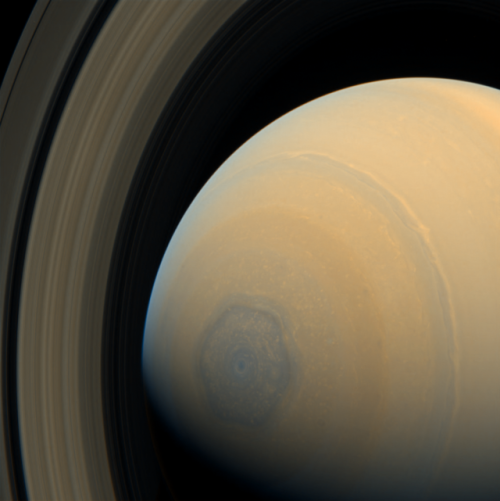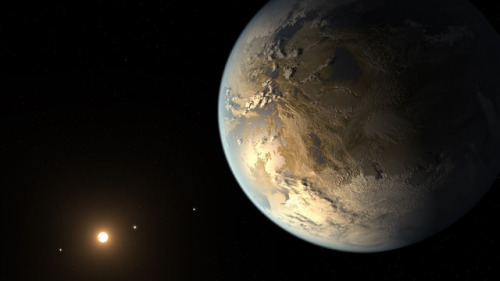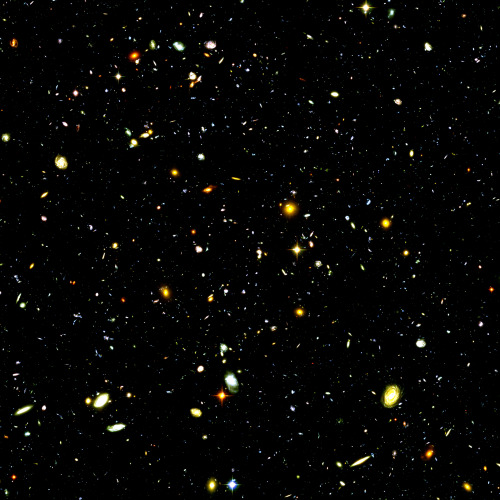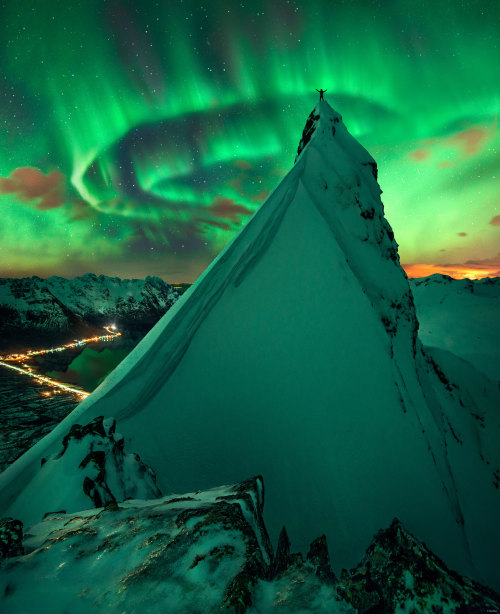Beautiful Saturn, Observed By The Cassini Probe On November 27, 2013.

Beautiful Saturn, observed by the Cassini probe on November 27, 2013.
(Ian Regan)
More Posts from Decimatethestars-blog and Others

Kepler-186f, the first Earth-size Planet in the Habitable Zone
js








TODAY IN HISTORY: Apollo 16 astronauts Charlie Duke and John Young train for the Moon at Kennedy Space Center in Florida, November 30, 1971.
(NASA)

The Hubble Ultra-Deep Field is an image of a small region of space in the constellation Fornax, containing an estimated 10,000 galaxies.
Image credit: NASA/ESA/Hubble
Boston Dynamics has shown off its new version of SpotMini, but now it’s also catching us up with its bipedal Atlas bot, the most humanoid of its creations. Atlas can now jump from elevated block to elevated block, and do a complete about-face in the air. It can leap pretty high, and also do a backflip – and then celebrate its backflipping ability. –

The faint rings of Uranus, shot in 1986, are made of countless fragments of water ice containing radiation-altered organic material.
Credit: NASA/JPL/Michael Benson, Kinetikon Pictures
Colors of Earth
When we think of our globe from a distance, we generally visualize two colors: blue and green. Water and land. Mostly water, consequently, our planet’s nickname of the blue marble.
Traveling around the globe every 90 minutes covering millions of miles with a focused lens on our beautiful planet from 250 miles above, I’ve captured many beautiful colors beyond blue and green that showcase Earth in new and interesting ways. Some colors are indicative of nature like desert sands and weather like snow. Other colors tell stories of Earth’s climate in bright splashes of yellows and greens of pollen and muted grey tones and clouded filters of pollution.
Blue and green still remain vivid and beautiful colors on Earth from the vantage point of the International Space Station, but here are some other colors that have caught my eye from my orbital perspective.

African violet

Bahamas blues

Tropical in Africa

Yellow desert

Orange in Egypt

Red surprise

Snow white
Follow my Year In Space on Twitter, Facebook and Instagram!
Look up at the super blue blood full moon Jan. 31 – here's what you'll see and why
by Shannon Schmoll

During the early hours of Jan. 31, there will be a full moon, a total lunar eclipse, a blue moon and a supermoon – all at the same time. None of these things is really all that unusual by itself. What is rare is that they’re happening all together on one day.
Keep reading
-
 chillypepperhot liked this · 2 years ago
chillypepperhot liked this · 2 years ago -
 biggienst liked this · 3 years ago
biggienst liked this · 3 years ago -
 gothic-music liked this · 3 years ago
gothic-music liked this · 3 years ago -
 animal-ior reblogged this · 3 years ago
animal-ior reblogged this · 3 years ago -
 euphonyhymns liked this · 4 years ago
euphonyhymns liked this · 4 years ago -
 mainew24 liked this · 4 years ago
mainew24 liked this · 4 years ago -
 mrfbking1958 liked this · 5 years ago
mrfbking1958 liked this · 5 years ago -
 fistofthistles reblogged this · 5 years ago
fistofthistles reblogged this · 5 years ago -
 eyesthebye reblogged this · 5 years ago
eyesthebye reblogged this · 5 years ago -
 scarlinga liked this · 7 years ago
scarlinga liked this · 7 years ago -
 tsteele67 liked this · 7 years ago
tsteele67 liked this · 7 years ago -
 dozierboy liked this · 7 years ago
dozierboy liked this · 7 years ago -
 mrvizion78 liked this · 7 years ago
mrvizion78 liked this · 7 years ago -
 rightcat reblogged this · 7 years ago
rightcat reblogged this · 7 years ago -
 hansomedevil liked this · 7 years ago
hansomedevil liked this · 7 years ago -
 pettieee reblogged this · 7 years ago
pettieee reblogged this · 7 years ago -
 princ3vamp liked this · 7 years ago
princ3vamp liked this · 7 years ago -
 carriebrownsteinscreaming reblogged this · 7 years ago
carriebrownsteinscreaming reblogged this · 7 years ago -
 miguelalmagro liked this · 7 years ago
miguelalmagro liked this · 7 years ago -
 skvwar liked this · 7 years ago
skvwar liked this · 7 years ago -
 alecway liked this · 7 years ago
alecway liked this · 7 years ago -
 proscriptus liked this · 7 years ago
proscriptus liked this · 7 years ago -
 virgo-world-62 liked this · 7 years ago
virgo-world-62 liked this · 7 years ago -
 fearandparadise liked this · 7 years ago
fearandparadise liked this · 7 years ago -
 koofteh liked this · 7 years ago
koofteh liked this · 7 years ago -
 vibel0rd reblogged this · 7 years ago
vibel0rd reblogged this · 7 years ago -
 crish---x liked this · 7 years ago
crish---x liked this · 7 years ago -
 comatose-joy reblogged this · 7 years ago
comatose-joy reblogged this · 7 years ago -
 cotgx reblogged this · 7 years ago
cotgx reblogged this · 7 years ago -
 jett-blck reblogged this · 7 years ago
jett-blck reblogged this · 7 years ago -
 jett-blck reblogged this · 7 years ago
jett-blck reblogged this · 7 years ago -
 jett-blck liked this · 7 years ago
jett-blck liked this · 7 years ago -
 gjc1968 liked this · 7 years ago
gjc1968 liked this · 7 years ago -
 cotgx reblogged this · 7 years ago
cotgx reblogged this · 7 years ago -
 enjoy003 liked this · 7 years ago
enjoy003 liked this · 7 years ago -
 pomfrittas liked this · 7 years ago
pomfrittas liked this · 7 years ago -
 thegiantskeleton reblogged this · 7 years ago
thegiantskeleton reblogged this · 7 years ago -
 seasidearie liked this · 7 years ago
seasidearie liked this · 7 years ago
eleon / 18 / they. aspiring astronaut. lover of biology and space.
25 posts


